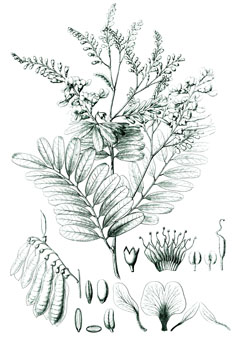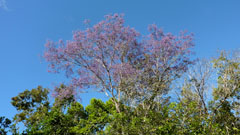 |
|
https://edibleplants.org/ |
 |
| Flickr - Alex Popovkin |
Translate this page:
Summary
Alcornoco, Bowdichia virgilioides, is a fairly fast-growing tree that can be used as pioneer species when restoring woodland. In the rainforest, it is a large evergreen tree up to 36 m tall but in the savannah it is much smaller and can grow up to 16 m only. Root tubercles and the bark are applied externally to treat various skin conditions. They are antirheumatic, astringent, depurative, febrifuge and hypoglycaemic. Seed oil is also applied externally for relief from articular pain. The wood is resistant to insect attack, hard, heavy, and very durable. Alcornoco is used in landscaping as an ornamental tree.
Physical Characteristics

 Bowdichia virgilioides is a deciduous Tree growing to 20 m (65ft) by 18 m (59ft) at a fast rate.
Bowdichia virgilioides is a deciduous Tree growing to 20 m (65ft) by 18 m (59ft) at a fast rate.
See above for USDA hardiness. It is hardy to UK zone 10. The flowers are pollinated by Insects.
It can fix Nitrogen.
Suitable for: light (sandy), medium (loamy) and heavy (clay) soils and prefers well-drained soil. Suitable pH: mildly acid, neutral and basic (mildly alkaline) soils. It cannot grow in the shade. It prefers dry or moist soil and can tolerate drought.
UK Hardiness Map
US Hardiness Map
Synonyms
Cebipira virgiliodes (Kunth) Kuntze
Plant Habitats
Edible Uses
References More on Edible Uses
Medicinal Uses
Plants For A Future can not take any responsibility for any adverse effects from the use of plants. Always seek advice from a professional before using a plant medicinally.
Antirheumatic Astringent Depurative Febrifuge Hypoglycaemic Skin
The root tubercles and the bark are antirheumatic, astringent, depurative, febrifuge and hypoglycaemic[739]. They are applied externally in the treatment of skin conditions[739]. The seed oil is rubbed on the skin to treat articular pain[739]. Lupeol and an alkaloid have been isolated from the bark[739].
References More on Medicinal Uses
The Bookshop: Edible Plant Books
Our Latest books on Perennial Plants For Food Forests and Permaculture Gardens in paperback or digital formats.

Edible Tropical Plants
Food Forest Plants for Hotter Conditions: 250+ Plants For Tropical Food Forests & Permaculture Gardens.
More

Edible Temperate Plants
Plants for Your Food Forest: 500 Plants for Temperate Food Forests & Permaculture Gardens.
More

More Books
PFAF have eight books available in paperback and digital formats. Browse the shop for more information.
Shop Now
Other Uses
Pioneer Wood
Other uses rating: High (4/5). Agroforestry Uses: A fairly fast-growing tree that grows well in full sun, fixes atmospheric nitrogen and can succeed in dry and poor soils. It can be used as a pioneer species when restoring woodland[ 419 ]. Other Uses The heartwood, is brown to reddish-brown; it is sharply demarcated from the narrow band of almost white sapwood. Lustre is low; growth rings not visible; texture coarse and uneven; grain rarely straight, usually cross or wavy; no distinct odour or taste are present[ 341 ]. The wood is hard, strong, stiff, fairly heavy, very durable and very resistant to insect attack[ 341 , 419 ]. Not easy to work with hand tools, particularly if cross grain is present; it can be planed to a good surface if a low cutting angle is used; rather difficult to nail, but nailing and screw-holding characteristics are good; finishes smoothly and takes a high polish; stains and glues well. A very decorative wood and a good joinery timber, it is used for indoor finishing as floorboards, wainscoting, frames, panels and doors, as well as for hubs, felloes of cartwheels etc[ 46 , 341 , 419 ].
Special Uses
Food Forest Nitrogen Fixer
References More on Other Uses
Cultivation details
Succeeds in a sunny position[ 419 ]. Found in the wild mainly on well-drained soils, it can succeed in both dry and poor conditions[ 419 ]. Established plants are drought tolerant[ 419 ]. A fairly fast-growing tree, able to reach a height of around 3 metres within 2 years from seed[ 419 ]. This species has a symbiotic relationship with certain soil bacteria, these bacteria form nodules on the roots and fix atmospheric nitrogen. Some of this nitrogen is utilized by the growing plant but some can also be used by other plants growing nearby.
References Carbon Farming Information and Carbon Sequestration Information
Temperature Converter
Type a value in the Celsius field to convert the value to Fahrenheit:
Fahrenheit:
The PFAF Bookshop
Plants For A Future have a number of books available in paperback and digital form. Book titles include Edible Plants, Edible Perennials, Edible Trees,Edible Shrubs, Woodland Gardening, and Temperate Food Forest Plants. Our new book is Food Forest Plants For Hotter Conditions (Tropical and Sub-Tropical).
Shop Now
Plant Propagation
Seed - it has a hard seedcoat and may benefit from scarification before sowing to speed up germination. This can usually be done by pouring a small amount of nearly boiling water on the seeds (being careful not to cook them!) and then soaking them for 12 - 24 hours in warm water. By this time they should have imbibed moisture and swollen - if they have not, then carefully make a nick in the seedcoat (being careful not to damage the embryo) and soak for a further 12 hours before sowing. Sow the seed in a sunny position in a nursery seedbed or in individual containers. A very low germination rate can be expected from untreated seed, with the seed sprouting within 30 - 60 days[ 419 ]. When the seedbed-sown seedlings are 5 - 6cm tall, pot them up into individual containers and they should be ready to plant out 5 - 6 months later.
Other Names
If available other names are mentioned here
Alcornoco, Bowdichia virgilioides.
Native Range
SOUTHERN AMERICA: French Guiana, Guyana, Suriname, Venezuela, Brazil, Bolivia, Colombia, Paraguay
Weed Potential
Right plant wrong place. We are currently updating this section.
Please note that a plant may be invasive in one area but may not in your area so it's worth checking.
None Known
Conservation Status
IUCN Red List of Threatened Plants Status : This taxon has not yet been assessed.

Growth: S = slow M = medium F = fast. Soil: L = light (sandy) M = medium H = heavy (clay). pH: A = acid N = neutral B = basic (alkaline). Shade: F = full shade S = semi-shade N = no shade. Moisture: D = dry M = Moist We = wet Wa = water.
Now available:
Food Forest Plants for Mediterranean Conditions
350+ Perennial Plants For Mediterranean and Drier Food Forests and Permaculture Gardens.
[Paperback and eBook]
This is the third in Plants For A Future's series of plant guides for food forests tailored to
specific climate zones. Following volumes on temperate and tropical ecosystems, this book focuses
on species suited to Mediterranean conditions—regions with hot, dry summers and cool, wet winters,
often facing the added challenge of climate change.
Read More
Expert comment
Author
Kunth
Botanical References
Links / References
For a list of references used on this page please go here
A special thanks to Ken Fern for some of the information used on this page.
Readers comment
| Add a comment |
|
If you have important information about this plant that may help other users please add a comment or link below. Only comments or links that are felt to be directly relevant to a plant will be included. If you think a comment/link or information contained on this page is inaccurate or misleading we would welcome your feedback at [email protected]. If you have questions about a plant please use the Forum on this website as we do not have the resources to answer questions ourselves.
* Please note: the comments by website users are not necessarily those held by PFAF and may give misleading or inaccurate information.
To leave a comment please Register or login here All comments need to be approved so will not appear immediately.
|
Subject : Bowdichia virgilioides
|
|
|
|